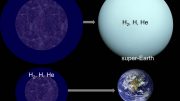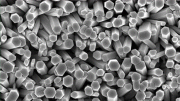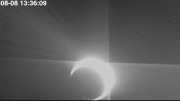A team of researchers has revealed that a common group of meteorites from Mars is almost 4 billion years younger than previously thought, providing scientists with a clearer picture of the Red Planet’s evolution.
A team led by Western University’s Desmond Moser has solved a Martian meteorite age puzzle that paints a much clearer picture of the Red Planet’s evolution that can now be compared to habitable Earth.
By directing energy beams at tiny crystals found in a Martian meteorite, a Western University-led team of geologists has proved that the most common group of meteorites from Mars is almost 4 billion years younger than many scientists had believed – resolving a long-standing puzzle in Martian science and painting a much clearer picture of the Red Planet’s evolution that can now be compared to that of habitable Earth.
In a paper published today in the journal Nature, lead author Desmond Moser, an Earth Sciences professor from Western’s Faculty of Science, Kim Tait, Curator, Mineralogy, Royal Ontario Museum, and a team of Canadian, U.S., and British collaborators show that a representative meteorite from the Royal Ontario Museum (ROM)’s growing Martian meteorite collection, started as a 200 million-year-old lava flow on Mars, and contains an ancient chemical signature indicating a hidden layer deep beneath the surface that is almost as old as the solar system.
The team, comprised of scientists from ROM, the University of Wyoming, UCLA, and the University of Portsmouth, also discovered crystals that grew while the meteorite was launched from Mars towards Earth, allowing them to narrow down the timing to less than 20 million years ago while also identifying possible launch locations on the flanks of the supervolcanoes at the Martian equator.
More details can be found in their paper titled, “Solving the Martian meteorite age conundrum using micro-baddeleyite and launch-generated zircon.”
Moser and his group at Western’s Zircon & Accessory Phase Laboratory (ZAPLab), one of the few electron nanobeam dating facilities in the world, determined the growth history of crystals on a polished surface of the meteorite. The researchers combined a long-established dating method (measuring radioactive uranium/lead isotopes) with a recently developed gently-destructive, mineral grain-scale technique at UCLA that liberates atoms from the crystal surface using a focused beam of oxygen ions.
Moser estimates that there are roughly 60 Mars rocks dislodged by meteorite impacts that are now on Earth and available for study, and that his group’s approach can be used on these and a much wider range of heavenly bodies.
“Basically, the inner solar system is our oyster. We have hundreds of meteorites that we can apply this technique to, including asteroids from beyond Mars to samples from the Moon,” says Moser, who credits the generosity of the collectors that identify this material and make it available for public research.
Reference: “Solving the Martian meteorite age conundrum using micro-baddeleyite and launch-generated zircon” by D. E. Moser, K. R. Chamberlain, K. T. Tait, A. K. Schmitt, J. R. Darling, I. R. Barker and B. C. Hyde, 24 July 2013, Nature.
DOI: 10.1038/nature12341
Image: Western University









Is there such a thing as hematite meteorites?
I have a couple of mars meteorites I’m sure would be beneficial to the program for further study,is it true the plagiclouse that posses the glassy black crystallized look with a purple hue is best for studying isotopes, 5302049405,have a smiley day.